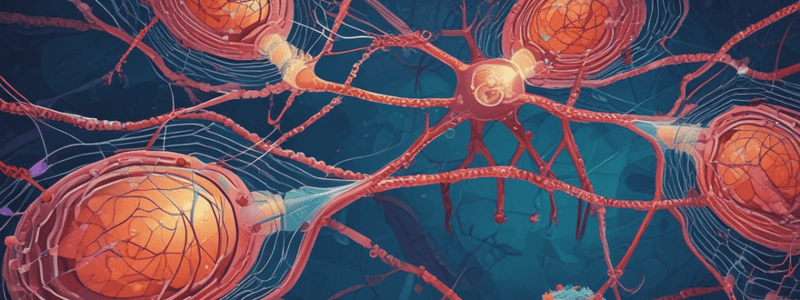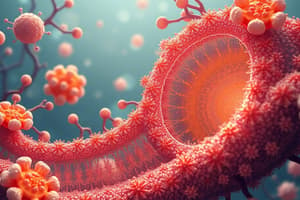Podcast
Questions and Answers
What is the modification that soluble proteins destined for lysosomes acquire in the Golgi?
What is the modification that soluble proteins destined for lysosomes acquire in the Golgi?
- ApoB-100 modification
- M6P modification (correct)
- Tyrosine modification
- Clathrin modification
What is the function of the M6P receptor in the Golgi?
What is the function of the M6P receptor in the Golgi?
- To degrade macromolecules
- To assemble clathrin coats
- To recognize and bind M6P-modified proteins (correct)
- To recycle LDL receptors
What is the purpose of Rab proteins in organelle trafficking?
What is the purpose of Rab proteins in organelle trafficking?
- To provide identity labels for organelles (correct)
- To facilitate protein folding in the ER
- To modify sugar structures in proteins
- To form vesicles for protein transport
What is the fate of the M6P receptor after the cargo dissociates from it in the late endosomes?
What is the fate of the M6P receptor after the cargo dissociates from it in the late endosomes?
What is the function of COPII vesicles in protein transport?
What is the function of COPII vesicles in protein transport?
What is the purpose of enzyme replacement therapy (ERT) in Gaucher disease?
What is the purpose of enzyme replacement therapy (ERT) in Gaucher disease?
What happens to Rab-GDP after it is released from the membrane?
What happens to Rab-GDP after it is released from the membrane?
What is the role of AP2 in the LDL receptor pathway?
What is the role of AP2 in the LDL receptor pathway?
What is the role of the KDEL sequence in COPI vesicle formation?
What is the role of the KDEL sequence in COPI vesicle formation?
What is the fate of LDL after it dissociates from its receptor in the endosomes?
What is the fate of LDL after it dissociates from its receptor in the endosomes?
What is the consequence of defective Rab proteins?
What is the consequence of defective Rab proteins?
What is the function of SNARE proteins in organelle trafficking?
What is the function of SNARE proteins in organelle trafficking?
What is the function of lysosomes in the cell?
What is the function of lysosomes in the cell?
What is the role of COPI vesicles in protein transport?
What is the role of COPI vesicles in protein transport?
Why do some lysosomal enzymes escape to the plasma membrane?
Why do some lysosomal enzymes escape to the plasma membrane?
What is the purpose of mannose-6-phosphate (M6P) in protein transport?
What is the purpose of mannose-6-phosphate (M6P) in protein transport?
What is the timeframe in which ion channels open and close?
What is the timeframe in which ion channels open and close?
What is the function of VGCaCs in the cell?
What is the function of VGCaCs in the cell?
What is the function of nicotinic acetylcholine receptors in muscle?
What is the function of nicotinic acetylcholine receptors in muscle?
What is the structure of voltage-gated cation channels?
What is the structure of voltage-gated cation channels?
How do Ca2+ channels exhibit ion selectivity?
How do Ca2+ channels exhibit ion selectivity?
What is the shape of the residues at the tip of TMD6 in closed channels?
What is the shape of the residues at the tip of TMD6 in closed channels?
What is the function of VGNa/KCs in the cell?
What is the function of VGNa/KCs in the cell?
What is the function of GABA/glycine receptors in the CNS?
What is the function of GABA/glycine receptors in the CNS?
Flashcards are hidden until you start studying
Study Notes
Vesicle Trafficking
- Proteins are packed into vesicles for trafficking from the ER.
- Rab proteins, a type of small G-protein, serve as identity labels for organelles.
- Rab is active when bound to GTP and inactive when bound to GDP.
Rab Activation and Inactivation
- Rab-GDP is recruited to intracellular membrane.
- Activation occurs when the host membrane has specific proteins to form Rab-GTP, allowing proof-reading.
- Recognition of Rab-GTP by another organelle is stabilized if it can hydrolyze Rab-GTP to form Rab-GDP.
- Rab-GDP is then released from the membrane to be re-used.
Diseases Caused by Defective Rabs
- Charcot Marie tooth disease 2B is caused by a Rab7 mutation.
- Legionnaire's disease is caused by a Rab1 mutation.
Protein Trafficking
- Proteins folded and N-glycosylated in the ER are collected into COPII vesicles.
- COPII vesicles move to the cis Golgi, where sugar structures of proteins are trimmed/modified.
- For proteins directed to lysosomes, mannose-6-phosphate (M6P) is attached.
COPII Vesicle Formation
- COPII proteins bind to a specific cytosolic sequence of proteins embedded in the ER membrane.
- They collect proteins into clusters with attached luminal proteins, which are then pinched off as small COPII vesicles.
- COPII vesicles move along microtubules to the cis Golgi, shedding their coat on the way.
Organelle Fusion
- SNARE (SNAP receptor) proteins mediate organelle fusion, drawing membranes close together.
- COPII vesicles must fuse with cis Golgi only, making recognition important.
COPI Vesicle Formation
- COPI vesicles move proteins from the Golgi to the ER.
- Luminal cargoes are recognized by a KDEL sequence, which binds to the KDEL receptor on the Golgi membrane.
- The COPI coat assembles, and subsequent events occur in reverse as the COPII vesicle mechanism.
Protein Trafficking from the Golgi
- Soluble proteins destined for lysosomes are recognized by the M6P modification acquired in the Golgi.
- They bind to the M6P receptor, which recognizes M6P at the luminal surface.
- They have short sequences that allow assembly of a clathrin coat at the cytosolic surface.
- Coated vesicles punch off from the Golgi, are transported, uncoated, and recognized by late endosomes, which they fuse with.
Lysosomal Functions
- Low pH causes the cargo to dissociate from the M6P receptor, which is transported back to the trans-Golgi.
- The cargo proceeds to a lysosome, where enzymes degrade imported materials and recycle macromolecules.
- Genetic differences in these enzymes underlie a variety of lysosomal storage diseases (LSDs).
Enzyme Replacement Therapy
- Imperfect targeting of M6P receptors allows some to escape to the plasma membrane, where they can be recovered to lysosomes by endocytosis.
- Administration of M6P-modified forms of missing enzymes in Gaucher disease results in the enzyme being endocytosed by the M6P receptor and delivered to lysosomes.
LDL Receptor Trafficking
- All cells express low-density lipoprotein (LDL) receptors, which bind to the ApoB-100 component of LDL.
- The cytosolic domain of the LDL receptor has sequences that interact with AP2 and thereby clathrin, which assembles LDL receptors and cargo into clathrin-coated pits for trafficking to endosomes.
- In the acidic lumen of endosomes, LDL dissociates from its receptor.
Ion Channels
- Ion channels open and close quickly, in less than 1 ms, and can allow several million ions to pass through.
- They mediate the fastest communication in the cell.
Regulation of Intracellular Activities
- Membrane potential changes are transduced as a messenger that enters the cell, typically calcium, through the opening of voltage-gated calcium channels (VGCaCs).
- VGNa/KCs are analogous to cables, while VGCaCs are analogous to the appliance, and VGICs are important therapeutic targets.
Nicotinic Acetylcholine Receptors
- Nicotinic acetylcholine receptors, found in muscle, respond to acetylcholine (ACh) released from pre-synaptic fibers.
- Drugs interacting with these receptors can relax muscle (during surgery) and treat myasthenia gravis (an autoimmune condition).
GABA/Glycine Receptors
- GABA/glycine receptors, which are chloride permeable, mediate most synaptic transmission in the CNS.
- Drugs targeted to these receptors are used to relieve anxiety and as general anesthetics.
Voltage-Gated Cation Channels
- Voltage-gated cation channels consist of 24 membrane spanning regions (4 × 6) arranged around a central pore.
- For Na+ and Ca2+ channels, the entire channel is comprised of a single protein chain.
- For K+ channels, four protein chains, each with six membrane-spanning domains, are required.
Ion Selectivity
- Ion selectivity arises from a narrow selectivity filter, where cations pass through single file, and surrounding amino acid residues interact.
- The selectivity filter of Ca2+ channels has two Ca2+ binding sites, which can bind Ca2+ selectively and tightly, allowing selectivity.
Channel Gating
- In closed channels, the residues at the tip of TMD6 come together to form a tepee shape, occluding the channel.
- The voltage sensor consists of four positively charged residues on TMD4, which move outwards in the plane of the membrane when the PM depolarizes.
- This movement pulls a short cytosolic helix linking TMD4-5, which links the voltage-sensor to TMDs forming the pore, leading to twisting of pore-lining helices and opening of the channel.
Studying That Suits You
Use AI to generate personalized quizzes and flashcards to suit your learning preferences.




